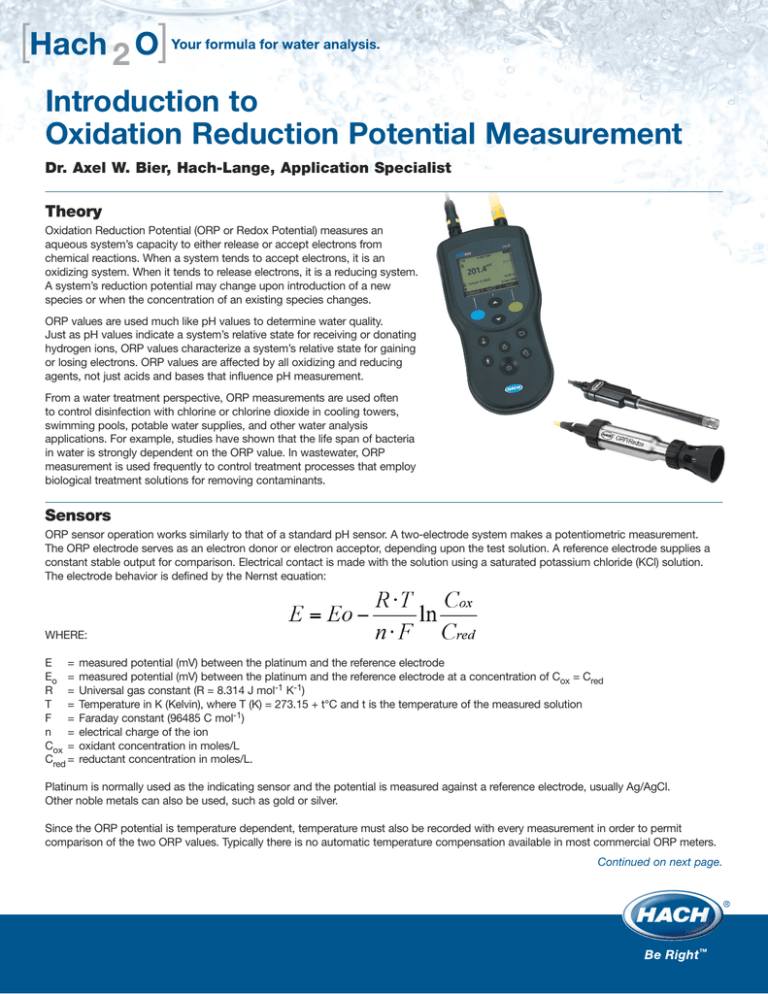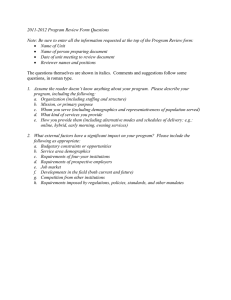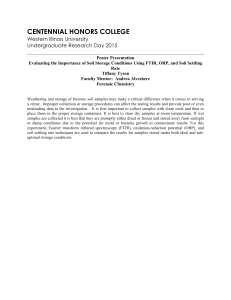
Introduction to
Oxidation Reduction Potential Measurement
Dr. Axel W. Bier, Hach-Lange, Application Specialist
Theory
Oxidation Reduction Potential (ORP or Redox Potential) measures an
aqueous system’s capacity to either release or accept electrons from
chemical reactions. When a system tends to accept electrons, it is an
oxidizing system. When it tends to release electrons, it is a reducing system.
A system’s reduction potential may change upon introduction of a new
species or when the concentration of an existing species changes.
ORP values are used much like pH values to determine water quality.
Just as pH values indicate a system’s relative state for receiving or donating
hydrogen ions, ORP values characterize a system’s relative state for gaining
or losing electrons. ORP values are affected by all oxidizing and reducing
agents, not just acids and bases that influence pH measurement.
From a water treatment perspective, ORP measurements are used often
to control disinfection with chlorine or chlorine dioxide in cooling towers,
swimming pools, potable water supplies, and other water analysis
applications. For example, studies have shown that the life span of bacteria
in water is strongly dependent on the ORP value. In wastewater, ORP
measurement is used frequently to control treatment processes that employ
biological treatment solutions for removing contaminants.
Sensors
ORP sensor operation works similarly to that of a standard pH sensor. A two-electrode system makes a potentiometric measurement.
The ORP electrode serves as an electron donor or electron acceptor, depending upon the test solution. A reference electrode supplies a
constant stable output for comparison. Electrical contact is made with the solution using a saturated potassium chloride (KCl) solution.
The electrode behavior is defined by the Nernst equation:
WHERE:
E =
Eo =
R =
T =
F =
n =
Cox =
Cred =
measured potential (mV) between the platinum and the reference electrode
measured potential (mV) between the platinum and the reference electrode at a concentration of Cox = Cred
Universal gas constant (R = 8.314 J mol-1 K-1)
Temperature in K (Kelvin), where T (K) = 273.15 + t°C and t is the temperature of the measured solution
Faraday constant (96485 C mol-1)
electrical charge of the ion
oxidant concentration in moles/L
reductant concentration in moles/L.
Platinum is normally used as the indicating sensor and the potential is measured against a reference electrode, usually Ag/AgCl.
Other noble metals can also be used, such as gold or silver.
Since the ORP potential is temperature dependent, temperature must also be recorded with every measurement in order to permit
comparison of the two ORP values. Typically there is no automatic temperature compensation available in most commercial ORP meters.
Continued on next page.
ORP measurements are often pH dependent. For example, chlorine exists in solutions as hypochlorous acid (HOCl), and depending on
the pH, the HOCl can provide more or less free chlorine. At lower pH values, more chlorine is formed.
ORP measurement readings occur slowly compared to pH measurements. While a pH value can be obtained within seconds, a stable
ORP value can take up to several minutes, if not hours, to reach the final equilibrium due to the type of reactions and their reaction rates.
The ORP measurement behavior is strongly influenced by the platinum surface condition. For example, a new, unconditioned ORP
electrode will show different values than an ORP electrode that has been conditioned and considered in use.
NOTE: Most natural waters contain many species that are involved in the redox process, making it more difficult to calculate ORP with the
Nernst equation. All redox species do, however, reach equilibrium. A standard solution of known redox potential for a particular ORP
electrode is used to calibrate the ORP sensor. The ORP sensor can then give a calibrated response in mV when placed in a sample.
The result of the redox measurement can be given as ORP or as “Eh.” The Eh value refers to the SHE (Standard Hydrogen Electrode) also
known as Normal Hydrogen Electrode (NHE), which is used to compare values between different ORP probe types. Normally, only the
absolute ORP mV value is recorded in order to see relative changes over time; Eh is then an unnecessary calculation.
Example: If using an Ag/AgCl reference electrode with 3M electrolyte solution, a measured redox potential
of +150 mV calculates to Eh = +360 mV, just by adding 210 mV for the potential shift from Ag/AgCl to SHE (@ 25°C).
For details, see Table 2.
Calibration/Check Standards
There are several redox standard solutions available, the most common of which are:
• ZoBell’s Solution
• Light’s Solution
• Quinhydrone Solutions
NOTE: The following mV readings at 20°C are given for an Ag/AgCl reference electrode with a 3M KCl filling solution.
Solution Preparation Instructions
ZoBell’s Solution
Soluble 2.64 g K4[Fe(CN)6] * 3 H2O and 2.06 g K3[Fe(CN)6] * H2O under stirring in 500 mL buffer pH 7.00 at 25°C.
After approximately 15 minutes of stirring, the solution is ready to use.
Potential @ 20°C = +228.5 mV ±5 mV
Light’s Solution
Soluble 1.861 g Fe(NH4)2 (SO4)2 * 6 H2O and 2.411 g Fe NH4 (SO4)2 * 12 H2O under stirring in 500 mL 1 M H2SO4 at 25°C.
After approximately 15 minutes of stirring, the solution is ready to use.
Potential @ 20°C = + 462.4 mV ±5 mV
Quinhydrone Solutions
Solution A: Add 3 g Quinhydrone to 500 ml buffer pH 4.01 and stir for 15 minutes. Un-dissolved Quinhydrone powder
must be present. If necessary, add Quinhydrone powder.
Potential @ 20°C = + 265.1 mV ±5 mV
Solution B: Add 3 g Quinhydrone to 500 mL buffer pH 7.00 and stir for 15 minutes. There must be an excess of undissolved
Quinhydrone powder. If necessary, add Quinhydrone powder.
Potential @ 20°C = + 87.4 mV ±5 mV
Electrode Calibration
Using a Hach HQd meter, select the ORP standard with the correct value vs. temperature. Rinse the probe with DI (DeIonized) water then
dip it into the selected ORP standard solution. Wait until the signal stabilizes. Take a reading. There can be a deviation from the theoretical
ORP value for that standard at that temperature. This offset (discussed in the next section) should be stored for future sample readings.
Continued on next page.
Table 1: mV Readings in ORP Standards
Acceptance Criteria for Calibration
For accurate sample measurements, check the ORP electrode performance against an ORP standard solution. The difference between
the standard mV potential and the measured mV potential is called the offset. As long as the reference electrode is working properly, the
ORP standard potential should be within ±10 mV for ORP probes in routine use, at a defined temperature. If desired, this offset may be
subtracted from the sample mV readings. The Hach HQd Meter Series and IntelliCAL™ Probes automatically subtract this offset during
sample measurement.
With use over time, and depending on the type of sample, the platinum disk or ring may become coated with chemical and/or biological
layers, which may cause a shift in potential (30-50 mV). Cleaning the probe periodically is therefore necessary.
Electrode Cleaning
If ORP measurements indicate a shift in potential over time, increased stabilization times or instable readings, electrode cleaning is
recommended. Conduct cleaning with minimal sensor surface impact, starting with standard cleaning and if this does not help, aggressive
cleaning (see instructions below). Be careful with your probe: Avoid aggressive and over frequent cleaning as it may be destructive and
lead to ORP probe replacement.
Standard Cleaning Procedures:
A. Soak the probe for 10-15 minutes in fresh tap water that contains a few drops of a commercial detergent such as
dishwashing soap. Additionally, wipe the Pt surface with a cotton cloth, but take care not to damage any part of the probe.
Afterwards, rinse with fresh tap water.
B. Soak the probe for 15 minutes in 0.1 M hydrochloric acid (HCl). Following safety instructions, wipe the Pt surface with a
cotton cloth or swab. Afterwards, rinse with fresh tap water.
Aggressive Cleaning Procedures:
C: Soak only the platinum element (not the reference junctions) for 1-2 hours in a 50:50 dilution of commercial chlorine bleach.
NOTE: Make sure that the diaphragm (ceramic pin or open junction etc. ) is NOT in the chlorine bleach.
Afterwards, rinse with fresh tap water and soak the probe for 1-2 hours in tap water to dilute the remaining bleach. It might be
necessary to repeat the rinsing to remove all bleach from the probe; otherwise, the results of the calibration and sample
measurement may be false due to the chlorine bleach.
D: Polish the Pt surface with an abrasive paper of 600 grid or higher, or use an extra fine grinding paste and polish with a cotton
cloth. Then soak the probe for 10 minutes in 1 M hydrochloric acid (HCl) and rinse thoroughly with fresh tap water.
To achieve the best, most reproducible results, let the probe rest for several hours. After following the cleaning procedures
described above (B,C,D), soak the ORP probe in the reference electrolyte solution overnight, then rinse with DI water and
calibrate. The offset in an ORP standard should be a maximum of ± 20 mV.
If the calibration is not satisfactory, or the offset is > 50 mV, replace the ORP probe.
Measurement in Various Applications
Typically, probes should be calibrated to verify performance. An ORP standard should be used to determine the actual mV offset value for
correction of measurement values. Take several readings in the same ORP standard to verify the final result.
Calculate the offset with the following formula:
Eoffset = Estandard - Emeasured [mV]
Add the mV offset to all sample results to adjust for the actual ORP probe performance. If necessary, also add the mV value for the
reference system used to get the reference mV value for SHE (standard hydrogen electrode).
ESHE = Eoffset + Ereference + Emeasured [mV]
Table 2: Ag/AgCl reference potentials vs. SHE
NOTE: Unlike conductivity (a similar situation applies to pH), there is no automatic temperature compensation for ORP sample
measurements. For ORP measurements, the temperature of the sample must always be recorded for further reference. Some samples
may also require recording the actual pH value, because some Redox couples are pH dependent.
Hach’s HQd Meter Series allows calculation of the offset from an ORP standard measurement (ORP calibration) and stores the actual
offset. This offset is then subtracted from each sample mV reading automatically.
Drinking Water
Drinking Water (DW) can be of very low ionic strength (e.g. 80 to 200 µS), causing problems with stabilization time and final readings.
After ORP probe calibration, rinse the probe with some of the DW sample and transfer it into a new beaker filled with the DW sample.
Wait at least 15 minutes for the first reading and then check every 5 minutes for stability. Depending on the temperature (lower values
take longer), and on the conductivity (lower values take longer), it might take several hours to get a final reading. Most pH/ORP meters
offer a stability function with adjustable or pre-defined stability criteria. Refer to the IntelliCAL User Instructions for specific stability
criteria information.
Surface Water
Typical surface water (SW) has a conductivity value exceeding 600 µS/cm, sometimes even in the mS/cm range. ORP measurement
can be performed immediately following calibration. Because rivers, reservoirs and wells contain sufficient ORP active species,
the measurement should be stable within 5 or 6 minutes.
Rinse the probe after each measurement with tap water to remove any biological films from the Pt surface. This will help keep the
Pt surface ready for measurement.
Wastewater
The composition of Wastewater (WW) characteristically contains sufficient ionic strength, temperatures below 20°C, and a composition of
chemical and biological contaminants. Depending on the location in the Wastewater Treatment Plant (WWTP)—influent, aeration basin,
nitrification/denitrification, effluent—samples can show different ORP values.
While the influent often comes with ORP readings around -200 mV, the WW stream changes the ORP to positive values of around +50 mV
due to oxidation of the reducing species.
ORP [ mV ]
Process
-280…-150
Development of methane
-200…+100
Reduction of sulfate
+180…+400
Reduction of iron
+220…+500
Reduction of manganese
+300…+600
Reduction of nitrate
Table 3: Typical ORP values of WW in a WWTP
ORP readings can be disturbed by air bubbles (aeration), floating particles, biological layers, etc. Therefore, it is essential for continuous
ORP control to be based on measurement in the same location, at the same depth and under reproducible conditions. It may be faster
to conduct a grab sample vs. waiting on a stable reading inside the basin or stream.
After each WW measurement the probe needs to be cleaned first with DI water, then detergent solution, followed by a final rinse with
DI water. Wipe the surface dry with a soft cloth and keep the probe in the recommended storage solution between measurements.
This procedure will assure a long probe lifetime along with reproducible and accurate results.
Standard Probe:
For Laboratory Use
Rugged Probe:
For Field Use
Call 800-227-4224 or visit: www.hach.com/SmartProbes
Lit. No. 2072
J9 Printed in U.S.A.
©Hach Company, 2009. All rights reserved. Trademarks are the property of their respective owners.



